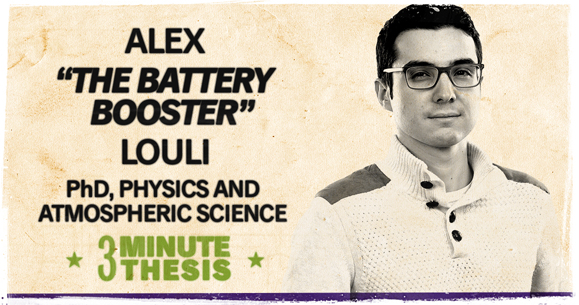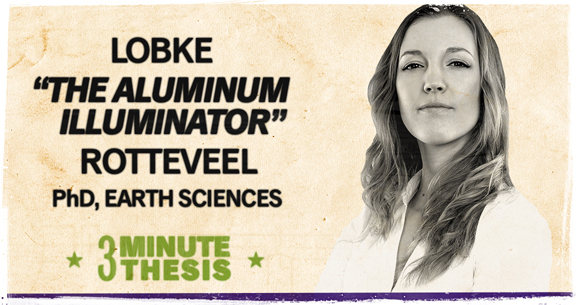On March 13, ten of Dalhousie’s brightest and boldest graduate students will square off in the final round of the 2019 Three Minute Thesis (3MT) competition.
Whittled from a field of 110 during preliminary heats, the contenders will vie for $4,000 in cash prizes and a chance to win an expense paid trip to Montreal for the regional competition at McGill University.
The finals take place Wednesday, March 13 from 6:30-8 p.m. in the McInnes Room of Dal's Student Union Building (6136 University Ave.)
Dalhousie graduate students do ground-breaking research. They explore cures for disease, solutions for social and environmental ills, and the art that illuminates our lives. 3MT is the public’s chance to learn about their discoveries — before they change the world.
With the timer set to just 180 seconds, the researchers will take the stage to present their ideas to a panel of judges and a live audience in the most engaging way possible. It’s an exhilarating blaze of brilliance and the best communicators come out on top.
Last year more than 200 people turned out for the finals and more than 10,000 watched the presentations via social media. Don’t miss your chance to be part of the excitement this year. Admission is free and a reception follows. (Let us know you’re coming on Facebook.)
To whet your appetite, we randomly selected five contenders to provide a taste of the talent vying for this year’s title.
MEET THE CONTENDERS
Seeing a better world through Kendrick Lamar
Dilshan “The Hip Hop Harmonizer” Weerasinghe
Describe your research
I’m studying how hip-hop artist Kendrick Lamar considers race, class and gender in his album To Pimp a Butterfly, and how he represents these issues through lyrics, musical language, jazz rhetoric and performance. By looking at the work of Kendrick Lamar, arguably the face of contemporary hip-hop, I’m studying how this individual, who grew up surrounded by poverty, police brutality, discrimination and gang violence, is able to transform thinking about race and social justice through art.
What is the one thing you want the audience to remember?
Hip-hop is a dominant cultural force. At some point in your day it’s likely you will experience hip-hop culture through music, fashion or slang, so it has the potential to be a great positive influence to provoke discussion around issues of race, class and gender.
Having the guts to determine between friends and foe
Emma “The Microbe Magnifier” Finlayson-Trick
Describe your research
Among the twists and turns of the gut are millions of bacteria. My research is focused on understanding how these microbes found in people who have Crohn’s disease are different from those of healthy people. In particular, I’m studying how a specific kind of bacterial protein is associated with gut inflammation. I want to understand how different bacterial populations might be important in helping someone stay in a non-diseased state or get to a point of healthy status.
What is the one thing you want the audience to remember?
We have these bacteria living in our gut that we can’t live without. While bacteria usually have a bad reputation as being our foe and causing diseases, there is actually a lot of bacteria that are good. We need to understand what they do.
Driven to make electric vehicles drive farther
Alex “The Battery Booster” Louli
Describe your research
Lithium ion batteries have been made better over the last 25 years, but we’re up to the limit of how much we can improve them with incremental change. The goal of our research is to introduce a major design improvement for lithium batteries that power electric vehicles that will increase their energy density by 50 per cent. If we increase energy density by 50 per cent, a car with a range of 300KM could drive 450KM and cost much less.
What is the one thing you want the audience to remember?
The new type of battery that we’re working on is a game-changer in that it’s a significant evolution in design. Range anxiety and cost are two major obstacles against the widespread adoption of electric vehicles. So, this is really important for developing a sustainable future.
In pursuit of the perfect grape
Prabahar “The Wine Wizard” Ravichandran
Describe your research
My research uses robotics, hyperspectral imaging and artificial intelligence to predict the phenolic levels in grapes that make the best wine. We are building an autonomous robot to go through vineyards and take images of grape clusters using a special camera that can capture extremely specific visual information. We feed this information into a computerized deep learning neural network. We show the network hundreds of pictures of a grapes, indicating the phenolic level of each of them. Based on that information the computer learns how to make accurate predictions of phenolic levels and therefore the best grapes.
What is the one thing you want the audience to remember?
If you want the perfect tasting wine, then you need our technology. We are harnessing AI that has only become available in the last five years. It has created breakthroughs in areas like language processing with programs like Siri and with self-driving cars. We are taking this technology and bringing it to wine growing and will take the industry to a whole new level.
Cleaning up the world’s water
Lobke “The Aluminum Illuminator” Rotteveel
Describe your research
When it was discovered in the 1970s and 1980s that acid rain was causing aluminum levels to increase in lakes and rivers, governments created laws to counteract it. However, members of the Dalhousie Hydrology Research Group and myself found that aluminum is still increasing, completely opposite to what we were expecting. I’m working on fixing this hole in our knowledge by answering where, when, why and how aluminum is increasing in lakes and rivers across the world.
What is the one thing you want the audience to remember?
For the scientists that are attending, I’m fixing a knowledge gap which is always the goal of science. But more importantly our research will show us where in the world aluminum is still a problem and it will show us how we can start fixing the problem. This will help us reduce the harm to our environment and the plants and animals who live in it.






